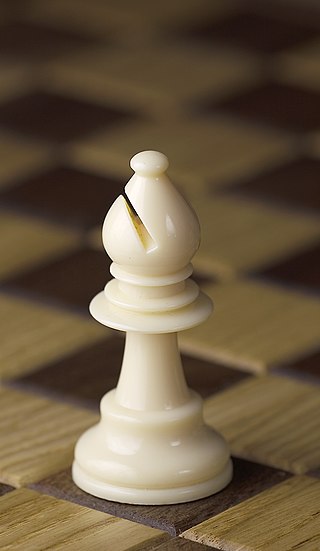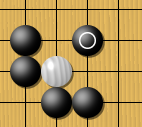
The bishop is a piece in the game of chess. It moves and captures along diagonals without jumping over intervening pieces. Each player begins the game with two bishops. The starting squares are c1 and f1 for White's bishops, and c8 and f8 for Black's bishops.

A chess piece, or chessman, is a game piece that is placed on a chessboard to play the game of chess. It can be either white or black, and it can be one of six types: king, queen, rook, bishop, knight, or pawn.

The pawn is the most numerous and weakest piece in the game of chess. It may move one vacant square directly forward, it may move two vacant squares directly forward on its first move, and it may capture one square diagonally forward. Each player begins a game with eight pawns, one on each square of their second rank. The white pawns start on a2 through h2; the black pawns start on a7 through h7.

The game of go has simple rules that can be learned very quickly but, as with chess and similar board games, complex strategies may be employed by experienced players.

Go is an abstract strategy board game for two players in which the aim is to surround more territory than the opponent. The game was invented in China more than 4,500 years ago and is believed to be the oldest board game continuously played to the present day. A 2016 survey by the International Go Federation's 75 member nations found that there are over 46 million people worldwide who know how to play Go, and over 20 million current players, the majority of whom live in East Asia.
This glossary of chess explains commonly used terms in chess, in alphabetical order. Some of these terms have their own pages, like fork and pin. For a list of unorthodox chess pieces, see Fairy chess piece; for a list of terms specific to chess problems, see Glossary of chess problems; for a list of named opening lines, see List of chess openings; for a list of chess-related games, see List of chess variants; for a list of terms general to board games, see Glossary of board games.

Go proverbs are traditional proverbs relating to the game of Go, generally used to help one find good moves in various situations during a game. They are generalisations and thus a particular proverb will have specific situations where it is not applicable. Knowing when a proverb is inapplicable is part of the process of getting stronger as a Go player. Indeed, several proverbs contradict each other—however they agree in as much as they are advising the player to pay attention to the stated situation.
Gonnect is a strategy board game for two players invented by João Pedro Neto in 2000. The game is played with standard Go equipment and basically uses the same rules as Go, however the goal of the game is to construct a group that connects any two opposite sides.
Martian Chess is an abstract strategy game for two or four players invented by Andrew Looney in 1999. It is played with Icehouse pyramids on a chessboard. To play with a number of players other than two or four, a non-Euclidean surface can be tiled to produce a board of the required size, allowing up to six players.
In chess, a tactic is a sequence of moves that each makes one or more immediate threats – a check, a material threat, a checkmating sequence threat, or the threat of another tactic – that culminates in the opponent's being unable to respond to all of the threats without making some kind of concession. Most often, the immediate benefit takes the form of a material advantage or mating attack; however, some tactics are used for defensive purposes and can salvage material that would otherwise be lost, or to induce stalemate in an otherwise lost position.

Life and death (死活) is a fundamental concept in the game of Go, where the status of a distinct group of stones is determined as either being "alive", where they may remain on the board indefinitely, or "dead", where the group will be lost as "captured". The basic idea can be summarized by:
In the game of Go, the empty triangle is the most fundamental example of the concept of bad shape.
Yari shogi is a modern variant of shogi ; however, it is not Japanese. It was invented in 1981 by Christian Freeling of the Netherlands. This game accentuates shogi’s intrinsically forward range of direction by giving most of the pieces the ability to move any number of free squares orthogonally forward like a shogi lance. The opposite is true of promoted pieces which can move backward with the same power.

Hasami shogi is a variant of shogi. The game has two main variants, and all Hasami variants, unlike other shogi variants, use only one type of piece, and the winning objective is not checkmate. One main variant involves capturing all but one of the opponent's men; the other involves building an unbroken vertical or horizontal chain of five-in-a-row.

Tenjiku shogi is a large-board variant of shogi. The game dates back to the 15th or 16th century and was based on the earlier chu shogi, which itself was based on dai shogi.
Chadarangam is a Telugu version of Indian chess, Chaturanga. It became very famous among kings and courtesans. Previously chariots (Ratha) were used in warfare, but in medieval times chariots were replaced by camels (Oṣṭra). So, the bishop in olden days was called Ratha / Śakaṭa and in medieval ages was called Oṣṭra.
Shogi, like western chess, can be divided into the opening, middle game and endgame, each requiring a different strategy. The opening consists of arranging one's defenses and positioning for attack, the middle game consists of attempting to break through the opposing defenses while maintaining one's own, and the endgame starts when one side's defenses have been compromised.

Chesquerque is a chess variant invented by George R. Dekle Sr. in 1986. The game is played on a board composed of four Alquerque boards combined into a square. Like Alquerque, pieces are positioned on points of intersection and make their moves along marked lines ; as such, the board comprises a 9×9 grid with 81 positions (points) that pieces can move to.

Congo is a chess variant invented by Demian Freeling in 1982 when he was nearly 8 years old. His father encouraged him to design a variant using a 7×7 gameboard. Demian was already familiar with chess and xiangqi, and the result blends some features from both. Congo became the second-most popular chess variant at the Fanaat games club in Enschede, the Netherlands.









